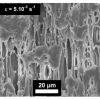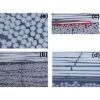Physics, Mechanics and Plasticity group

SEM image during a Videotraction test on PP / EPR at T = 30 ° C and for a residual deformation of 1.2 showing the damage phenomenon by cavitation

Différents mécanismes d’endommagement dans les composites stratifiés : (a) Décollement fibre/matrice, (b) craquelures de la matrice, (c) Délamination, (d) Rupture de fibres
Last publications
- Temperature and associated effects on water diffusion in poly(lactic acid)
Pan Wang, Tian-Tian Li, Xinchong Wei, Marc Ponçot, Sandrine Hoppe, Guo-Hua Hu
Chemical Engineering Science, 2026, 319, pp.122358. ⟨10.1016/j.ces.2025.122358⟩ - High-performance mixed matrix membranes with very-high ZIF-8 loading for efficient CO2 capture
Carole Arnal-Herault, Thomas Arzoumanian, Maria Valentina Velasco Rueda, Bouchra Belaissaoui, Marc Ponçot, Nathalie Steunou, Subharanjan Biswas, Eliane Espuche, Anne Jonquieres
Polymer, 2025, 336, pp.128858. ⟨10.1016/j.polymer.2025.128858⟩ - Melt mixing activated Zn-BDC MOF for sustainable packaging: enhancing barrier properties in PLA/PCL nanocomposites
Meriem Guira, Samia Kerakra, Marc Ponçot, Tayeb Bouarroudj, Abderrahmane Habi
Journal of Materials Science, 2025, ⟨10.1007/s10853-025-11490-5⟩
Presentation
The Mechanical Physics and Plasticity group studies the microstructures and elementary mechanisms of deformation and damage to materials. Its research activity takes advantage of the complementary skills of specialists in metals, polymers and composites.
With a long expertise in the design of original assemblies, the group links physical and mechanical laws of behavior established from experimental tests according to different deformation paths coupled with an in situ technique of experimental characterization.
Some recent developments include:
- couplings: mechanical tests (VideotractionTM Patent FR No.2,823,849) / Raman spectroscopy (Patent FR 2981452 (B1) / WO 2013054062 N ° 1159297) / X-ray diffraction on polymers
- the development of a high resolution diffraction technique suitable for monocrystalline superalloys.
A large part of the group's work uses X-ray diffraction or X-ray synchrotron tomography during in situ experiments on installations such as ESRF, DeSy, ELETTRA which allow measurements in real time.
The acquisition of a 3D stereocorrelation device, coupled with a videotractionTM test and / or a bulge test (bulge test), makes it possible to probe the multiaxial mechanical properties (full field and out of field).
The strength of the group is therefore based on the use of three complementary approaches:
- Development of experiences (in situ coupling),
- Theoretical models (law of behavior)
- Simulations (FFT modeling, finite elements)
This research responds to several important societal challenges, such as: transport, environment, health and energy. This research is financially supported by the LabEx DAMAS (LABoratory of EXcellence Design of Alloy).
Research topics
Polymer materials microstructure / physical properties relationship (coordinators: Isabelle Royaud, Marc Ponçot)
The scientific developments of the goup are focused on understanding the impact of long-term aging processes on mechanical behavior.
This approach involves monitoring the evolution of the microstructure under mechanical stress, knowing that aging (physical or chemical) may be due to:
- degradation with oxidation
- scission and / or crosslinking of macromolecule chains
- thermal degradation of the material at high strain rates
- a structural evolution (crystallinity, orientation, physical aging in the amorphous phase, volume damage)
- interfacial damage in composites, degradation phenomena specific to aggressive environments (for example, biomaterials for a bioartificial pancreas resistant to aging in vivo)
The overall objective is to predict long-term mechanical behavior, based on an understanding of the plasticity and damage of different types of materials. This approach must lead to the prediction of long-term service life, in particular in the context of the development of sustainable and eco-compatible materials.
Projects:
- FUI MECABARP
- Welding Institute (IS)
- Renault
Theses:
- Arkema / CEA / INES, Stéphane OGIER (2014-2017)
- FUI Mecabarp, Martin DONNAY (2014- 2017)
- Solenne COLLOMB (2017-2020)
Article:
In situ study of the deformation micro-mechanisms of semicrystalline polyethylene terephthalate films using synchrotron radiation X-ray scattering, Polymer, 117, 268-281, 2017, Martin Donnay; Marc Ponçot; Jean-Philippe Tinnes; Thomas Schenk; Olivier Ferry; Isabelle Royaud,
Monitoring and identification of elementary mechanisms of deformation and damage to materials (coordinators: Thomas Schenk, Isabelle Royaud, Marc Ponçot)
The scientific activity of the group is based on the understanding and modeling of the mechanical behavior of innovative materials from elementary micro-mechanisms of deformation:
- displacement of dislocations and defects in the case of metallic materials
- molecular mobility of macromolecules
- volume or composite damage (at the level of the fibers, the matrix or the fiber / matrix interface).
The materials studied are very varied: metallic materials, polymers, biomaterials (up to living material) and composites.
Projects:
- LabEx DAMAS
- MIB project
- CNES
Theses:
- MESR, Khaoula BEN HAFSIA (2013-2016)
- LabEx DAMAS, Komlavi SENYO ELOH (2017-2020)
Article:
Study of the Poly (Ethylene Terephthalate) crystallization by coupling Raman Spectroscopy and Differential Scanning Calorimetry, Journal of Polymer Research, 23 (5), 1-14, 2016, K. Ben Hafsia, M. Ponçot, P. Bourson, D. Chapron, I. Royaud
Mechanics of damage to composites (coordinator: Zoubir Ayadi)
The overall scientific objective is to assess the effect of damage to composites on the elastic properties of the structure. Good progress has been made so far in the case of static loads. This research work mainly focuses on understanding fatigue damage. The two main themes are:
- Microcracks and delaminations of laminated composites subjected to quasi-static and cyclic loading.
- Study of the effect of the microstructure on the initiation and the spread of detachment at the fiber-matrix interface by Representative Elementary Volume (VER) models for unidirectional composites and cross laminates.
This objective is developed in the framework of a strong partnership with the Technical University of Lulea in Sweden.
Three approaches are used: Theoretical (global-Local model), Experimental (full field method) and numerical (finite elements). They are divided into two sub-themes:
- Introduction of Micro Damage and growth in laminates under quasi-static tensile loading and fatigue
- Fatigue damage to thin composites for aeronautical applications.
Theses:
- Hiba BEN KHALA
- Luca DI STASIO
Articles:
Energy release rate of the fiber / matrix interface crack in UD composites under transverse loading: effect of the fiber volume fraction and of the distance to the free surface and to non-adjacent debonds, Theoretical and Applied Fracture Mechanics, 103, 102251, 2019, Luca Di Stasio, Janis Varna, Zoubir Ayadi
Correlation microscopic / macroscopic behavior considering the heterogeneity of materials. Study of the Representative Elementary Volume (coordinators: Thomas Schenk, Marc Ponçot, Isabelle Royaud)
The group draws on its skills in matter physics (crystal defects in macromolecular architecture), to develop original coupled mechanical characterizations (diffraction, spectroscopy, etc.) with modeling of mechanical behavior.
It is based on experimental laboratory resources, from the atomic scale (MET, SEM) to the molecular scale (Raman spectroscopy) and on real-time in situ diffraction using large synchrotron type instruments at the mesoscopic scale.
To achieve their objectives, the team continues to develop original experimental devices, such as:
- its high temperature in situ mechanical testing machine under synchrotron radiation, which allows access to the 1300 ° C-1600 ° C temperature range to study new materials at very high temperatures, under more complex stressing modes
- its full field measurements
- its videometric control of mechanical tests
- its bulge test of thin metallic or polymer membranes (with 3D stereocorrelation)
- their multi-technical couplings: WAXS, SAXS, DSC, Raman spectroscopy, dynamic dielectrical analysis, tensile test, X-ray tomography with synchrotron radiation
Projects:
- Arcelor Mittal
- Nippon Steel
Theses:
- MESR, Adrien LETOFFE (2016-2020)
- MESR, Roxane TREHOREL (2015-2018)
- LabEx DAMAS, Komlavi SENYO ELOH (2017-2020)
Articles:
- Resilience improvement of an isotactic polypropylene-g-maleic anhydride by crosslinking using polyether triamine agents, Polymer, 179, 121655, 2019, Adrien Létoffé, Sandrine Hoppe, Richard Lainé, Nadia Canilho, Andreea Pasc, Didier Rouxel, Rafael J. Jiménez Riobóo, Sébastien Hupont, Isabelle Royaud, Marc Ponçot
Know-how
High temperature in situ experimentation with synchrotron radiation. New high-speed measurement techniques and modeling
Examples:
- Studies of the creep of metallic materials using in situ X-ray diffraction of synchrotron radiation and high temperature furnace
- In-situ and in-operando studies of microstructure and mechanical behavior under load of metals and alloys
- Study of elementary deformation mechanisms in situ using synchrotron radiation during the creep of high resistance / high temperature alloys
- Modeling of diffraction peaks with the fast Fourier transformation method (FFT): in order to compare the results of theoretical mechanical simulations and experimental X-ray diffraction data
Coupling in situ Raman spectroscopy and videotractionTM for the study of polymer deformation
Examples:
- Study and understanding of the macroscopic mechanical properties of polymeric materials (VideotractionTM and 3D stereocorrelation)
- In situ monitoring of polymer deformation by Raman spectroscopy (evolution of the orientation factor, the crystallinity ratio and the volume damage)
- In situ experimentation in the study of polymers by combining simultaneously synchrotron radiation X-rays, videometric traction test (VideoTractionTM) and Raman spectroscopy
Determination of the link between defects and mechanical properties of composites (three approaches: experimental, numerical and theoretical)
Example: Study of the damage of multilayer materials in composite materials
Characterization of the physical properties of metallic materials, polymers, composites and biomaterials
- Plasticity, damage, aging / durability of materials
- Multi-scale characterization (mechanical and structural) of innovative materials for different societal challenges (energy, transport, health, environment)
Examples:
- Study of the mechanical properties of multimaterials (metals, polymers and composites) through the study of deformation mechanisms
- Determination of a plasticity limit criterion for polymer membranes: mechanical swelling test (bulge test)
- In situ study of the microstructure of polymers by X-ray diffraction in synchrotron radiation
- Study of the mechanical properties of polymers by videometric tensile tests (VideoTractionTM)
- In vitro study of the mechanical properties of biomaterials
- Study of the influence of the charge rate of composite odontological resins (fluids) on the mechanical and physico-chemical properties of materials
- Microstructural characterization of metals and alloys
Technology transfer
Creation of the start-up ProViSys Engineering in order to enhance and transfer the experimental know-how of the team (patents: VideotractionTM 2002 and Coupling of VideotractionTM and Raman spectroscopy 2011) http://www.provisys-eng.com/ Fr/
Members
Professors, assistant professors
- Zoubir AYADI
- Rémy BALTHAZARD
- Abdesselam DAHOUN
- Yves MESHAKA
- Eric MORTIER
- Marc PONCOT
- Isabelle ROYAUD
- Jean-Philippe TINNES
Post-doctoral researchers
- Jissy JACOB
PhD students
- Hao KONG
Emeritus
- Gérard MICHOT
Nancy-Artem
Institut Jean Lamour
Campus Artem
2 allée André Guinier - BP 50840
54011 NANCY Cedex

Find and establish the relationships between the true mechanical behaviour laws at the macroscopic scale & the micromechanisms of deformation at the chains and structures scales
